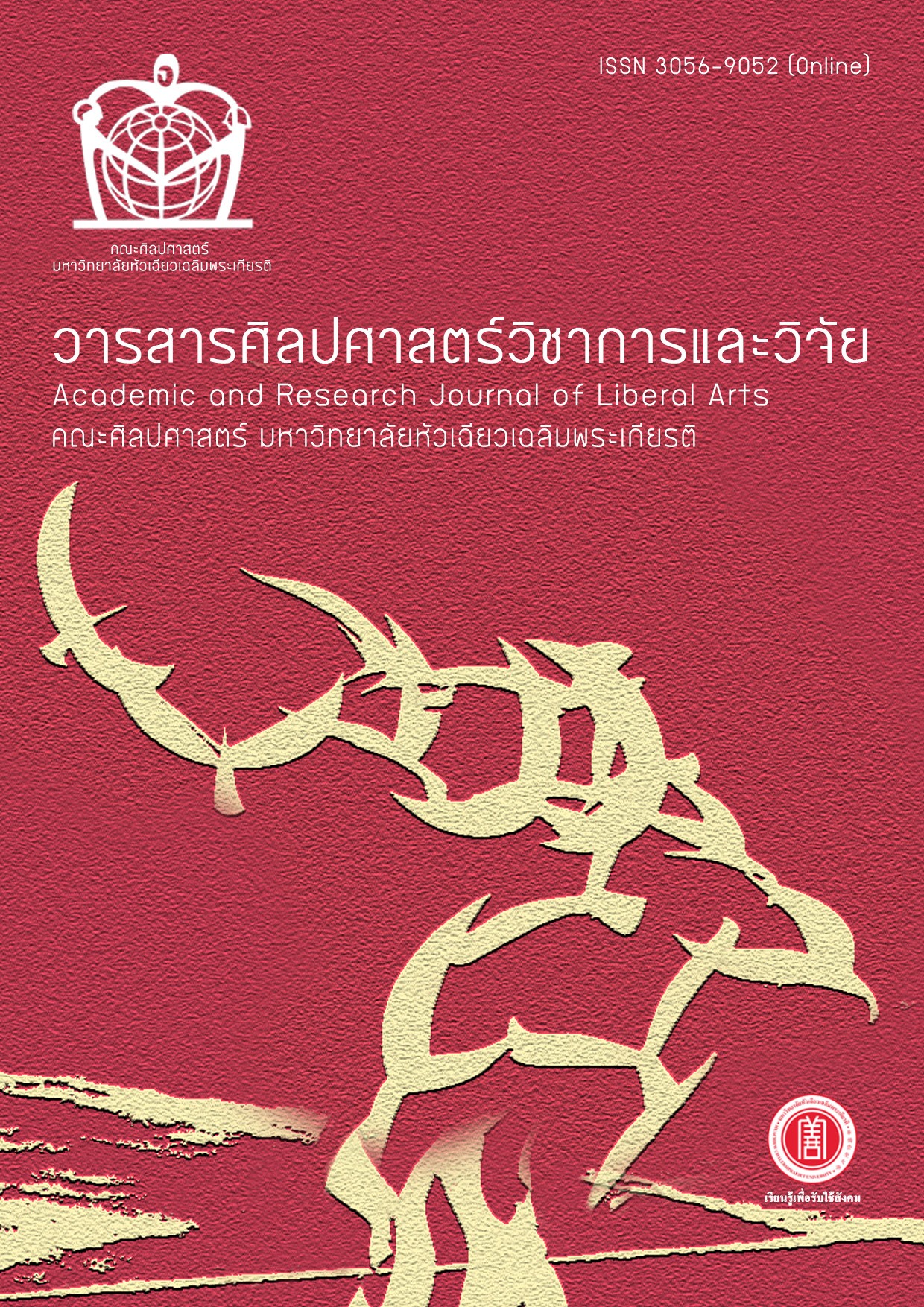Verbal and Nonverbal Communication for Cross-Cultural Communication: a Case Study of International Affairs between Huachiew Chalermprakiet University in Thailand and Higher Educational Institutes in People’s Republic of China
DOI:
https://doi.org/10.14456/arjla.2024.3Keywords:
Using Verbal and Nonverbal, Cross-Cultural Communication, International Affairs, Huachiew Chalermprakiet University, Higher Educational Institutes in People’s Republic of ChinaAbstract
This qualitative research aims to analyze verbal and nonverbal communication used in international affairs, focusing on academic cooperation, between Huachiew Chalermprakiet University (HCU), in Thailand, and higher educational institutes in People’s Republic of China. Twenty-four research samples were purposively selected, including five individuals from HCU, and nineteen individuals from eleven higher educational institutes engaged in academic cooperation with HCU. The research identifies three tactics used in verbal communication in cross-cultural contexts: 1) Academic terms normally used in education industry and related to international affairs. 2) Specific terms or pronouns that emphasize job position, academic title, or qualification, and which should be used in accordance with the other party's customs to show respect and honor. 3) Languages used in cross-cultural communication primarily include Thai and Chinese, with English documents sometimes utilized. In terms of non-verbal communication, six aspects are observed: 1) Greeting manners, introductions in order, exchanging business cards, paying respects, shaking hands, smiling, and gently nodding. 2) Dress code, which should be polite and formal, including wearing national costumes when appropriate. 3) Facial expressions that are suitable for the situation. 4) Conference seating arrangements, where the Thai side prefers to have the president sit at the head of the table, while the Chinese side prefers to have the president sit in the middle of the table and facing each other. 5) The use of signs, with both sides attaching importance to the use of the institution's name and logo on various occasions. 6) The selection of gifts that represent an institution, city, or nation, which should be properly considered for cross-cultural communication between Thailand and China in international affairs.
References
จันทิมา พงษ์พันธุ์. (2548). การสื่อสารเชิงวัจนภาษา (ภาษาพูด) ผ่านรูปแบบการสื่อสารแบบรวบรัด กรณีศึกษา ธุรกิจร้านอาหาร ธุรกิจตลาดประมูลสินค้า และธุรกิจการบินระหว่างประเทศ (วิทยานิพนธ์ปริญญามหาบัณฑิต). มหาวิทยาลัยธุรกิจบัณฑิตย์, กรุงเทพมหานคร.
จิราภรณ์ สมิธ และพฤกษพรรณ บรรเทาทุกข์ (2559). การศึกษาปัญหาการใช้ภาษาอังกฤษในบริบทการสื่อสารระหว่างวัฒนธรรมระหว่างเจ้าหน้าที่ตรวจคนเข้าเมืองและชาวต่างชาติ. วารสารวิชาการนวัตกรรมสื่อสารสังคม, 2(8), 46-57.
ฉันทัส ทองช่วย. (2543-2544). งานวิเทศสัมพันธ์เป็นงานสำคัญของคณะมนุษศาสตร์และสังคมศาสตร์. วารสารปาริชาติ, 13(2), 3-5.
นริศรา เกตวัลห์ และคณะ. (2564). ภาษาไทยกับการสื่อสาร. กรุงเทพมหานคร: สาขาวิชาภาษาและวัฒนธรรมไทย คณะศิลปศาสตร์ มหาวิทยาลัยหัวเฉียวเฉลิมพระเกียรติ.
มัทณศิลป์ วงศ์จันทร์. (2562). การรับรู้ปัญหาการสื่อสารและกลวิธีการสื่อสารที่ผู้ขายคนไทยใช้ในการสื่อสารกับนักท่องเที่ยวที่พูดภาษาอังกฤษในจังหวัดเชียงใหม่ (วิทยานิพนธ์ปริญญามหาบัณฑิต). มหาวิทยาลัยพะเยา, พะเยา.
เมตตา วิวัฒนานุกูล (กฤตวิทย์). (2559). การสื่อสารระหว่างวัฒนธรรม (พิมพ์ครั้งที่ 2). กรุงเทพมหานคร: สำนักพิมพ์จุฬาลงกรณ์มหาวิทยาลัย.
วิไล ธรรมวาจา. (2564). การศึกษาระดับความรู้ความเข้าใจและปัจจัยที่ส่งผลต่อการเรียนรู้วัฒนธรรมไทยของนักศึกษาแลกเปลี่ยนชาวจีนมหาวิทยาลัยหัวเฉียวเฉลิมพระเกียรติ. วารสารศิลปศาสตร์ปริทัศน์,16(2), 1-17.
หวง ซืออี้ (2560). การเรียนการสอนและสื่อการเรียนการสอนการอ่านข่าวบนพื้นฐานการสื่อสารข้ามวัฒนธรรม. วารสารจีนศึกษา มหาวิทยาลัยเกษตรศาสตร์, 10(2), 225-256.
Yuan, X. Y. (2015). The manifestation of the differences between Chinese and Western cultures in cross-cultural communication.
Scientific Chinese, (10X), 195.
Zu, X. M. (2015). Intercultural Communication. Beijing: Foreign Language Teaching and Research Press.
Downloads
Published
How to Cite
Issue
Section
License
Copyright (c) 2024 Liberal Arts Review

This work is licensed under a Creative Commons Attribution-NonCommercial-NoDerivatives 4.0 International License.
บทความที่ได้รับการตีพิมพ์เป็นลิขสิทธิ์ของวารสารศิลปศาสตร์วิชาการและวิจัย
ข้อความที่ปรากฏในบทความแต่ละเรื่องในวารสารวิชาการเล่มนี้เป็นความคิดเห็นส่วนตัวของผู้เขียนแต่ละท่านไม่เกี่ยวข้องกับมหาวิทยาลัยหัวเฉียวเฉลิมพระเกียรติ และคณาจารย์ท่านอื่นๆ ในมหาวิทยาลัยฯ แต่อย่างใด ความรับผิดชอบองค์ประกอบทั้งหมดของบทความแต่ละเรื่องเป็นของผู้เขียนแต่ละท่าน หากมีความผิดพลาดใดๆ ผู้เขียนแต่ละท่านจะรับผิดชอบบทความของตนเองแต่ผู้เดียว




